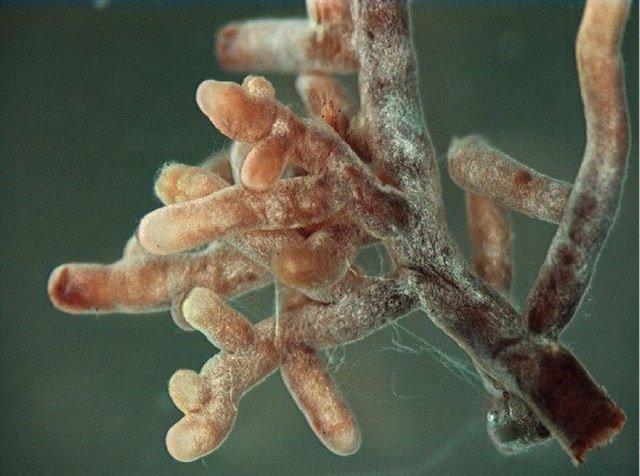We’re in the depth of winter here in northern Minnesota, we’ve put our gardens and fields to bed and the snow has blanketed everything. But down under that snow, there’s a mighty village of microbes working hard to get ready for spring. Meet the heavy lifters: fungi, bacteria, actinomycetes and archaea are active, maybe just a bit slower in the cold, but they’re cooperating to feed our plants. It was just in 2010 that Swedish researchers discovered that soil microorganisms actually maintain activity during the winter, transforming carbon just like they do in the summer, but more slowly. And they are legion. There are more of these critters in a teaspoon of healthy soil than there are humans on the planet!
Mycorrhizal root tips
They’re invisible to most of us. But we know something about them. Most of us know what fungi are, for example—even if we’ve only seen them in mushroom or mold manifestations. Mycorrhizae are fungi that live around plant roots and interact symbiotically with the roots. There are different varieties, depending on whether they grow their hyphae (the filaments that make up the mycelium) inside the plant roots or outside of them. The bottom line is that they eat root exudates (excreted sugars) and poop good stuff that plant roots like in return. And when it gets too cold for them, they set spores which will sprout as soon as the soil warms a bit.
Actinomycetes are organisms between fungi and bacteria. They are like bacteria, but they can form branches like fungi. And some of them can freeze and still keep on working—they have membranes that don’t burst when their innards turn to ice. Bacteria are familiar to most of us as “germs.” They, along with the other microbes, transform nitrogen and store nitrogen, even in winter. We think of them as “bad,” but they’re essential underground just like they are in our own human guts (google “gut biome” for more than you want to know).
A more primitive microbe than bacteria is the archaea. These are single-celled organisms that outnumber all the others. It’s estimated that there are thousands of species of archaea living in the soil. They’re hard at work at thirty-two degrees. Some of them are experts at oxidizing ammonia into nitrate which is essential for plant nutrition. Researchers testing soil in Colorado in 2018 found a dramatic increase in the abundance of bacterial and fungal populations in midwinter followed by a decrease during the snowmelt period. In 2020, other researchers documented a similar “microbial bloom” sixty-five days prior to snowmelt and then a flush of Nitrogen after snowmelt when the microbes crash. It’s an active cycle, keeping the soil teeming with life even in northern Minnesota winters….in healthy soil, that is.
Mycelium
So how can you boost your soil’s ability to keep all these bugs going? There are steps you can take in the fall to help. Don’t till! Tilling is like taking a bulldozer to your soil, destroying the intricate webs created by all these creatures. If you believe you must get some air into the soil, use a broad fork. Don’t rake your leaves! Or do rake them toward your gardens and fields and wildflower areas and use them as mulch. Add compost as mulch or drench the soil with compost tea before covering. You can purchase compost if you don’t make your own. And you can find easy recipes for compost tea on the Internet. Plant cover crops—plants native to your area. Keeping roots in the soil always helps. They prevent erosion and support microbes in addition to preventing weeds. And leave the snow where it falls on your garden. The snow blanket is a good insulator as well as being a fertilizer. Did you know that, as snowflakes fall through the air, they pick up atmospheric nitrogen and gift it to your garden?
Snow insulates the ground and helps the underground critters
And in the spring, don’t rake the leaves or cover off or cut back perennials until the temperature has been above fifty for a week. All of the insects, especially pollinators, who nest in leaf litter and dried winter branches of perennials are still waking up. And we need them just as much as we need the underground critters. It all comes back to life in its own good time.
I know you’re wondering how to find out whether the soil in your field or garden has enough microbes. This is the fun part! And you can do it this coming spring. It’s called “Bury your Briefs” or “Soil your Undies.” Stay with me here…..all you need is a pair of 100% cotton briefs or undies. Bury them in your field or garden when the soil warms in the spring. After a couple of months, dig them up. (Better explain to neighbors first.) If they’re intact, you’re in trouble, or at least your soil is. If all that’s left is an elastic waistband, your soil is full of enough microbes and you’re in good shape for the growing season. Google Bury your Briefs or Soil your Undies and you’ll find numerous videos and contests and photos.
I’ll close with this wish: May your undies be totally devoured and your garden grow well!


